Mastering Bread-Making: A Complete Guide
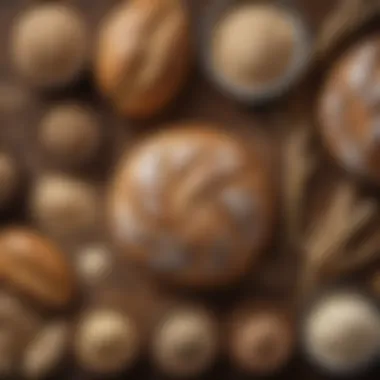
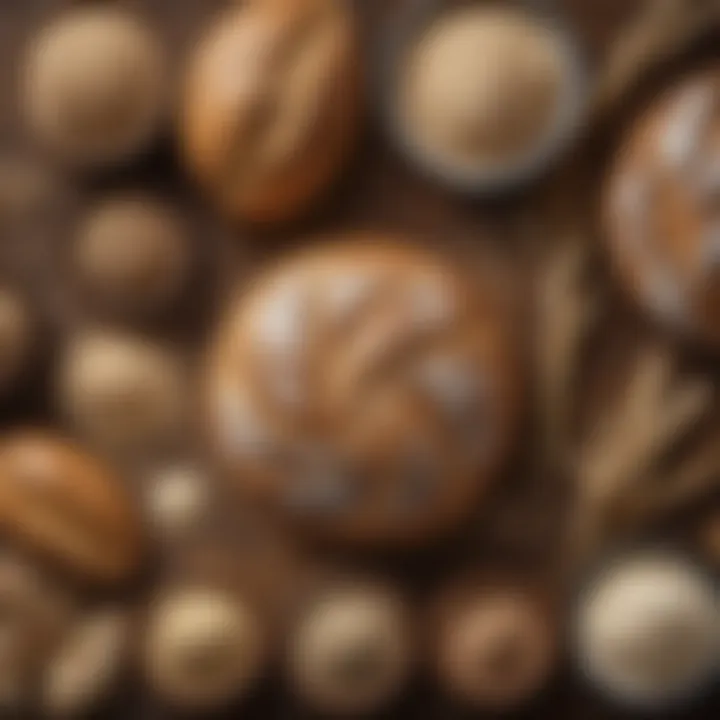
Intro
Baking bread is an age-old craft that brings comfort to many kitchens. Whether you’ve strolled through artisanal bakeries or simply enjoyed the smell wafting from the oven at home, bread has an undeniable power to soothe. Today, we’ll peel back the layers of bread-making, revealing not just the how-tos but also the heart behind the loaves we cherish.
Bread, at its core, is a simple blend of flour, water, yeast, and salt. Yet, it transforms in profound ways through technique, passion, and a sprinkle of creativity. This guide aims to invite both budding bakers and seasoned chefs to explore the artistry of creating their favorite types of bread—from crusty sourdough to soft brioche.
Baking delves deep into various cultures, traditions, and preferences around the globe. It’s a narrative we can all relate to—a shared experience of warmth, sustenance, and celebration. Throughout this journey, readers will discover key ingredients, master techniques, tackle common pitfalls, and spark thoughts about bread's cultural significance.
We aim to facilitate a holistic approach to baking. Embracing not just recipes, but the rich tapestry of stories that intertwine humanity and bread. Let’s embark on this delectable expedition!
Recipe Highlight
Featured Recipe: Rustic Sourdough Bread
Rustic sourdough bread holds a unique place in the hearts of many bakers. Its tangy flavor and satisfying crust make it a must-try. Here's what you need to get started:
Essential Ingredients:
- 500g strong white bread flour
- 350ml water
- 100g active sourdough starter
- 10g salt
Estimated Time:
Preparation time is about 30 minutes, with a fermentation period of around 12 hours and baking time spanning 40-50 minutes.
Servings:
This recipe yields one large loaf, perfect for sharing or enjoying throughout the week.
Step-by-Step Instructions
- Mix the Dough: In a large bowl, combine 500g flour, 350ml water, and 100g sourdough starter. Mix until no dry flour remains.
- Autolyse: Let the dough rest for 30 minutes. This allows the flour to fully hydrate and enzymes to start breaking down.
- Add Salt: Sprinkle 10g salt over the dough and mix until integrated.
- Bulk Fermentation: Cover your bowl with a damp cloth and let it rise at room temperature for 6-12 hours. Every 30 minutes, stretch and fold the dough to strengthen it.
- Shape: Gently turn the dough onto a floured surface, shape it into a round loaf, and place it seam-side up in a floured proofing basket.
- Second Rise: Cover and let the bread rise for 1-2 hours until puffy.
- Preheat the Oven: Preheat your oven to 220°C (425°F) with a Dutch oven inside for at least 30 minutes.
- Score: Gently turn the loaf out onto parchment paper and score the top with a sharp knife.
- Bake: Carefully transfer the dough into the preheated Dutch oven. Cover and bake for 30 minutes, then uncover for an additional 15-20 minutes until golden brown.
- Cool: Allow the bread to cool on a wire rack before slicing.
"Baking bread is both a science and an art, each loaf tells a story."
Variations and Substitutions
- Flour Options: You can experiment with whole wheat flour for a nuttier flavor or use gluten-free flour blends if needed.
- Additions: Consider throwing in herbs like rosemary or garlic for added zest. Chopped olives or sun-dried tomatoes can also elevate your bread.
- Serving Ideas: Pair your rustic sourdough with a variety of toppings—from classic butter and jam to a savory cheese platter.
Time-Saving Cooking Tips
- Prep Ahead: Mix your sourdough starter the night before to ensure it’s bubbly and active.
- Tools: A bench scraper makes handling dough a breeze, while a kitchen scale ensures precise measurements.
- Batch Baking: If you have the time, consider baking multiple loaves at once. They freeze well for later enjoyment.
Nutritional Information
- Calories: Approximately 200 calories per slice.
- Nutrients: Provides essential carbohydrates, a decent amount of fiber if using whole grain, and small amounts of protein.
- Diet Suitability: Naturally yeast-leavened bread can often be easier to digest than commercial bread, making it suitable for many dietary plans, including those with mild gluten sensitivities.
In summary, there’s much more than meets the eye in the world of bread. Each loaf prepared is an opportunity to connect with a rich history and culture while satisfying the palate. Enjoy making and sharing your very own loaf of rustic sourdough!
Prolusion to Bread-Making
Bread is more than just a staple food; it’s a bridge to our past and a pause in our present. The very act of bread-making has a tapestry of cultural significance woven into it. This comprehensive guide aims to shed light on the importance of this ancient culinary practice, drawing both newbies and seasoned bakers into the delightful world of flour, water, yeast, and salt.
Understanding the Importance of Bread
Bread has held a revered position in cuisines around the globe. It’s not simply nourishment; bread acts as a symbol of community, sustenance, and even celebration. Across centuries, different societies have held bread crafting in high esteem. What makes this baked good so significant?
- Cultural Symbol: Bread appears in ritualistic and traditional customs. It can signify hospitality—a fresh loaf welcoming guests to your home.
- Nutrition Benefits: When made with whole grains, bread can be a powerful source of fiber and essential nutrients, stimulating gut health and providing steady energy.
- Versatility: From sandwiches to artisan loaves, bread caters to numerous tastes and diets, making it a universal favorite.
When embarking on your baking journey, understanding these facets provides a broader perspective. It transforms the process of making bread from a mundane task into a creative expression.
A Brief History of Bread
To comprehend bread-making today, one must glance back to history. This journey stretches back thousands of years and shows how bread has evolved.
The earliest evidence of bread dates back to ancient Mesopotamia, around 14,000 years ago, before the advent of agriculture. Early humans realized that grinding grains and mixing them with water created a nourishing, flavorful dough. Over time, baking methods shifted from stone ovens to clay and brick structures.
- Ancient Civilizations: Egyptians honed the art of bread-making, refining techniques with yeast and creating a variety of doughs.
- The Middle Ages: Bread was a critical part of diets across Europe. The quality of bread reflected social status, with white bread being a delicacy for the wealthy.
- Modern Era: The Industrial Revolution brought mass production. While this made bread more accessible, it often compromised nutritional quality.
Today, there’s a resurgence in artisanal baking, as many seek authentic, handmade bread, echoing traditions long forgotten. Understanding this history not only makes us appreciate what we eat but also encourages us to participate in a rich lineage of culinary practices.
"Bread is the staff of life; it carries the weight of history, culture, and nourishment."
As you navigate this culinary journey of bread-making, keep this context in mind. Each loaf you bake is tied to generations of bakers who came before you—an artistic creation, a family heritage, and a simple delight in life.
Essential Ingredients for Bread
When it comes to bread-making, the ingredients you choose aren't merely personal preferences; they are foundational elements that can dramatically affect the character and quality of your final loaf. Understanding what goes into your bread and why it matters positions you for success in the kitchen. Every ingredient serves a specific function, contributing to flavor, texture, and rise, ultimately offering a range of results that can cater to any taste or dietary need.
Flours of the World
Flour, in its myriad forms, serves as the backbone of bread. The variety you select can dramatically alter your loaf. All-purpose flour is a common go-to, versatile in many recipes, but bread flour, with its higher protein content, promotes better gluten strength and elasticity, making it a champion in yeast bread making.
Beyond these staples, the global market provides a wealth of options:
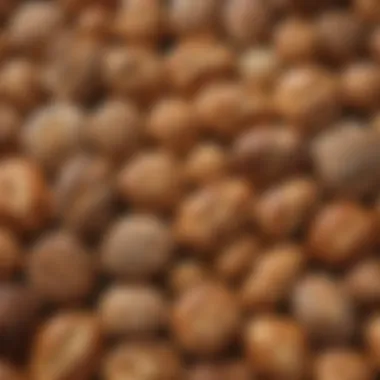
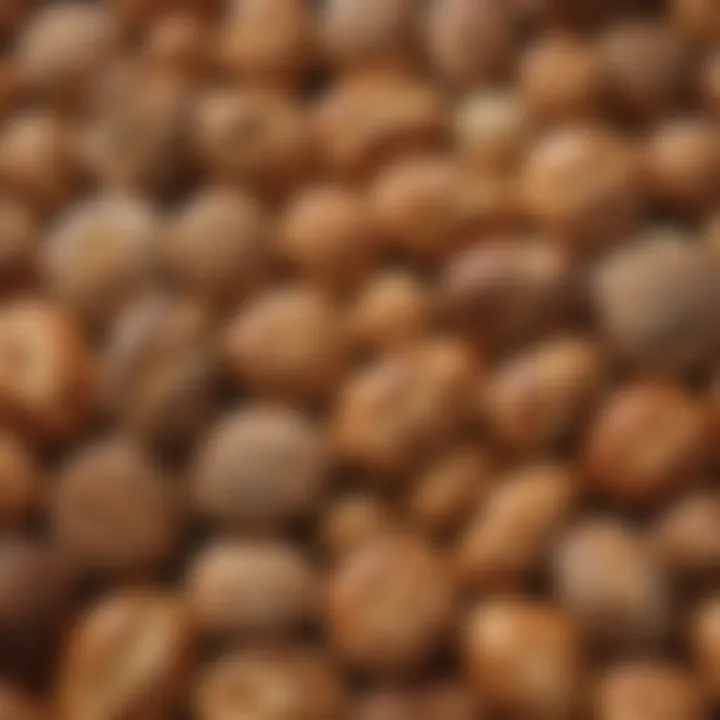
- Rye Flour: Offers a distinct flavor and dense texture, often found in traditional Eastern European breads.
- Whole Wheat Flour: Holds more nutrients as it uses the entire grain, but requires additional water due to its higher absorption rate.
- Specialty Flours: Such as spelt and kamut, bring unique flavors and characteristics but may need adjustments in hydration and gluten balance.
Thus, exploring flours not only broadens your repertoire but enhances your understanding of what each type contributes to the bread-making process.
Yeast Varieties and Their Roles
Yeast is the magical agent of fermentation, breathing life into your dough. There are two primary types to consider: dry yeast and fresh yeast. Dry yeast, often referred to as instant or active dry yeast, is easy to store and quick to activate, making it a baker’s best friend. Fresh yeast, while a bit trickier to handle, can provide a unique depth of flavor and is often preferred in artisan baking.
Additionally, there are sourdough starters: a wild yeast and bacteria mix that not only ferments the dough but also imparts a complex sour flavor, giving your bread that artisanal touch. Choose your yeast according to your baking goals, complexity, and time commitment; each choice will steer your bread-making journey along its distinct path.
Water: The Most Vital Ingredient
Water’s role in bread-making is often understated. It hydrates the flour, activating the gluten and allowing yeast to do its work. The quality of your water is important as well; hard water can inhibit yeast activity, while soft water accelerates it.
You also need to consider temperature. Using warm water can help speed up fermentation, while cool water provides a slower, more controlled process yielding richer flavors. Measuring your water carefully is essential. Too little can lead to dry bread, while too much can create sticky dough that’s hard to manage. This simple, yet crucial ingredient anchors the entire baking process.
Salts, Sugars, and Fats
These ingredients, while secondary, play vital roles in enhancing the characteristics of the bread. Salt is not just a flavor enhancer; it regulates yeast activity, strengthens the gluten structure, and contributes to the overall taste. Be mindful of the quantity used; too much can inhibit rise, while too little can lead to bland outcomes.
Sugars, ranging from table sugar to honey and molasses, don’t merely sweeten. They also fuel yeast, add color to the crust, and create a tender texture by interacting with proteins.
Lastly, fats like butter or olive oil can enrich the dough, ultimately affecting crumb softness and enhancing flavor. However, be cautious with your fats; too much can make the dough heavy and impede rise.
In summary, the essential ingredients form the bedrock of your bread. By selecting the right components and understanding their roles, you bring both science and artistry into your baking.
"The right combination of ingredients holds the key to unlocking the perfect loaf."
The journey of bread-making is as layered as a good croissant; it starts with knowing your ingredients and goes on to mastering techniques and flavors.
Exploring Bread Types
Bread comes in numerous forms, each with its character and flair, weaving itself into the fabric of our meals and rituals. Exploring different bread types not only enhances our culinary skills but also offers a glimpse into the cultural significance and diversity surrounding this staple food. Understanding the various bread categories ensures that anyone baking can select the right fit for any occasion or meal, making the process efficient and enjoyable.
Artisan Breads
Artisan breads represent the pinnacle of traditional baking, often crafted by passionate bakers who treat their craft as an art form. These breads, characterized by their unique flavors and textures, are made with high-quality ingredients and often incorporate local or seasonal products.
Some well-known artisan breads include:
- Ciabatta: An Italian favorite known for its crispy crust and airy interior.
- Baguette: A staple of French cuisine, recognized for its long, thin shape and chewy texture.
- Focaccia: This is an olive oil-rich flatbread, often topped with herbs and vegetables.
Making artisan bread can take time and patience, but the results are worth it. Kneading, fermenting, and scoring each loaf creates a personal touch, resulting in something that truly reflects the baker's skills and creativity.
"Artisan bread is not just about the ingredients; it’s about a story woven into every loaf, reflecting the place and people who made it."
Sourdough: The Classic Choice
Sourdough bread, with its rich, tangy flavor, has captured hearts over centuries. What sets it apart is its unique fermentation process—using naturally occurring yeasts in the environment instead of commercial yeast. This slow fermentation not only enhances flavor but also improves the bread’s digestibility.
To bake sourdough, one must master the art of developing a starter, which involves a careful balance of flour and water left to ferment over days. Its characteristic crusty exterior and chewy inside make it a versatile choice for sandwiches or toast, giving each bite a complexity that commercial breads often lack.
Quick Breads for the Busy Cook
Quick breads are a lifesaver in today's fast-paced life. Unlike traditional bread which demands lengthy fermentation and rising time, quick breads use baking powder or baking soda as leavening agents, allowing for swift preparation.
Examples of quick breads include:
- Banana Bread: Ideal for using overripe bananas, this loaf is dense and often packed with nuts or chocolate.
- Cornbread: Common in Southern cuisine, cornbread is sweet and pairs beautifully with chili or barbeque.
- Zucchini Bread: A great way to sneak in veggies, this moist bread often combines the sweetness of zucchini with cinnamon and nuts.
Quick breads are appealing not just for their speed but also their flexibility, allowing creativity with flavors and add-ins.
Whole Grain and Gluten-Free Options
In recent years, there’s been a significant shift toward whole grain and gluten-free breads, catering to various dietary preferences and health consciousness. Whole grain breads retain all parts of the grain, offering higher fiber content and nutrients compared to white bread.
Whole grain options include:
- Whole Wheat Bread: Dense and nutty, rich in fiber.
- Rye Bread: It has a distinctive flavor and is often paired with meats and cheeses.
For those avoiding gluten, gluten-free bread alternatives made from flours such as almond, coconut, or rice provide options. While gluten-free bread can sometimes yield different textures, many recipes come close to mimicking the original. Choosing whole grain or gluten-free options not only broadens one’s baking repertoire but also pays heed to today’s health considerations.
Fundamental Techniques in Bread-Making
Bread-making is not just about following a recipe; it’s about understanding various techniques that transform basic ingredients into a loaf of bread. These fundamental techniques serve as the backbone of bread-making and are vital for achieving the desired flavor, texture, and appearance. Mastering these techniques allows bakers to troubleshoot and adapt when things don't go according to plan, ensuring successful results even in the face of culinary mishaps.
Kneading: Techniques and Tips
Kneading is one of the most crucial steps in creating bread. It develops gluten, which gives bread its structure and chewy texture. There are various methods to knead dough; some prefer the traditional push-fold technique, where you use the heel of your hand to push the dough away from you, then fold it back over itself. Others might opt for the slap-and-fold method, which incorporates air into the dough.
- Tips:
- Start with a clean, floured surface to prevent sticking.
- Keep your hands lightly oiled or floured to ease the kneading process.
- If the dough feels too sticky, gradually sprinkle a bit more flour.
Proper kneading typically takes around ten minutes, but experience may guide how you feel the dough become smoother and more elastic.
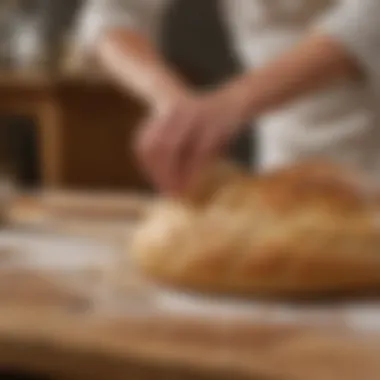
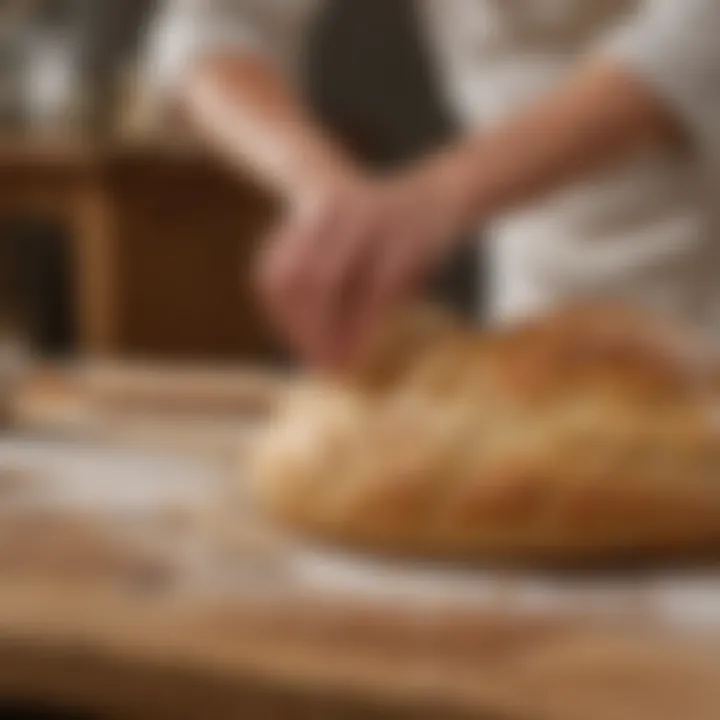
"Kneading is to bread what a good workout is to the body — it strengthens and shapes the outcome from ordinary to extraordinary."
Fermentation: Understanding the Process
Fermentation is where the magic happens. This is when the yeast ferments the sugars in the dough, producing carbon dioxide and alcohol. This process not only helps the bread rise but also allows for flavor development. It can be split between bulk fermentation, where all ingredients sit together, and proofing, which is the final rise before baking.
- Key Considerations:
- Temperature plays a huge role: Yeast is happiest in warmer conditions, but too much heat can kill it.
- Patience is key; rushing fermentation with high temperatures can yield poor results.
Learning to gauge the right time for fermentation can be the difference between a dense loaf and a beautifully airy one.
Shaping and Scoring Techniques
Once your dough has risen appropriately, shaping it becomes essential for creating a consistent structure. Shaping involves forming the dough into its final shape, whether it be a round loaf or a baguette. Scoring, or making slashes on the top of the dough, is equally important; it allows for controlled expansion during baking and an aesthetic touch.
- Shaping Tips:
- Scoring Methods:
- Use a bench scraper to help move dough without deflating it.
- Consider practicing various shapes for different bread styles.
- A sharp blade or lame can create precise cuts.
- Experiment with designs, but maintain a balance between art and function.
Baking: Achieving the Perfect Crust
The final technique to master is baking. This is where the bread transforms from dough to a final product. The ideal baking temperature and time can vary widely among bread types, so it’s critical to pay attention. A steam-injected oven can offer fantastically crisp crusts by creating moisture in the initial phase of baking.
- Baking Tips:
- Preheat your oven adequately to ensure proper rise and crust.
- Use an oven thermometer for accuracy.
- Consider baking on a pizza stone for even heat distribution.
Achieving that golden-brown crust is often tied closely to the final internal temperature of the loaf; a well-baked loaf often registers around 195°F to 210°F internally.
By understanding these foundational techniques in bread-making, bakers can elevate their culinary skills, creating loaves that not only satisfy the stomach but warm the heart.
Navigating Common Challenges
When baking bread, it’s not all sunshine and rainbows. Many bakers face challenges along the way, which can be frustrating. This section digs into those hiccups that may crop up during the bread-making process—because understanding how to navigate these challenges is half the battle. It’s about finding solutions that ensure your bread rises to the occasion, quite literally. Addressing these hurdles can not only elevate your bread-making experience but also create a sense of mastery in the kitchen.
Dealing with Dough Consistency Issues
Dough consistency is right at the heart of successful bread-making. Achieving the right balance can make all the difference. For beginners, it might feel like chasing after the wind at times. Dough can easily turn out too wet or too dry, which can lead to disappointments. When dough is too wet, it may stick to your hands like glue, making it nearly impossible to handle. On the other hand, if it’s too dry, you end up with a crumbly mess that resembles sand more than bread.
To address this issue:
- Measure accurately: Use a digital scale for flour and water. Sometimes a cup of flour can weigh different amounts depending on how it’s scooped.
- Consider your environment: Humidity can affect flour absorption, so adjustments may be needed based on the weather.
- Adjust slowly: When adding water or flour, do it gradually. A little can go a long way, and it’s easier to correct the consistency step by step.
Troubleshooting Fermentation Problems
Fermentation is essentially where the magic happens. During this stage, dough transforms under the action of yeast, producing carbon dioxide that gives bread its rise. However, several issues can disrupt this crucial process. If fermentation is too rapid, you might find your dough over-fermented, leading to a flatbread that’s as disappointing as a wet sock. Conversely, under-fermentation might leave you with a dense loaf that almost feels like a paperweight.
To effectively troubleshoot:
- Watch the temperature: Yeast thrives in warm surroundings. If your kitchen is too cold, consider placing the dough in a slightly warm oven to facilitate fermentation.
- Timing is everything: Keep an eye on how long the dough sits. It’s not just about following the recipe; it's about visual cues. If it doubles in size, it’s ready.
- Use the right yeast: Not all yeasts are created equal. Active dry yeast, instant yeast, and fresh yeast have varied activation times. Make sure you know what you're working with.
Achieving Desired Bread Texture
Texture can often be a make-or-break factor in bread-making. One look at that crusty exterior and tender crumb can make your heart skip. Yet, achieving the perfect texture is often a juggling act of ingredients and techniques. A bread loaf that’s too dense or too airy may leave you yearning for more.
To help guide your texture goals:
- Kneading is key: Proper kneading distributes ingredients and develops gluten, which affects the final texture. Remember, over-kneading can toughen the dough, while under-kneading leads to a weak structure.
- Experiment with hydration levels: A higher hydration dough typically yields a more open crumb. Start with a wetter dough and adjust it according to preference.
- Know your bake times: Timing directly influences texture. An undercooked loaf will be gummy and dismal, while an overcooked one will be too hard. Trust your instinct and give it a little poke.
"Every loaf you bake brings you one step closer to understanding the art of bread, embracing each challenge without fear."
Navigating through these common challenges not only aids in becoming a more skilled baker but enriches the appreciation for the craft of bread-making itself. Baking is, at its core, an intricate dance of science, artistry, and sometimes a bit of luck.
Cultural Significance of Bread
Bread holds a special place in cultural narratives across the globe. It's much more than mere sustenance; it embodies tradition, community, and history. Each loaf tells a story, often intertwined with local customs and beliefs. To understand the value of bread within various cultures, one must look beyond the kitchen. It’s pivotal to grasp that bread represents different things in different regions—unifying the past with the present and bridging generations.
Bread in Different Cultures
Throughout the ages, bread has been a cornerstone of numerous societies. In Europe, for instance, bread is tied to every meal, and in certain regions, it even goes as far as being considered a sacred entity. In France, the baguette is not just a food item; it’s a symbol of national pride and daily life. Locals often share a baguette over dinner, emphasizing the communal aspect of breaking bread together.
In Middle Eastern cultures, bread is a vital component of daily diets. The pita bread serves not only as a vehicle for dips like hummus or baba ganoush but as an integral part of social life. Often, it is served at gatherings, signifying hospitality and warmth.
Similarly, in Mexico, tortillas reshape the concept of bread yet maintain its significance. They are used in various classic dishes, woven deeply into family recipes passed from ancestors to younger generations.
"Man does not live by bread alone, but bread is essential to his journey."
Other cultures have bread that symbolizes more than sustenance. For instance, the round panettone in Italy represents festivity and is commonly associated with Christmas celebrations. It’s shared among family and friends, reinforcing bonds while indulging in flavors of rich fruits and spices.
Rituals and Celebrations Involving Bread
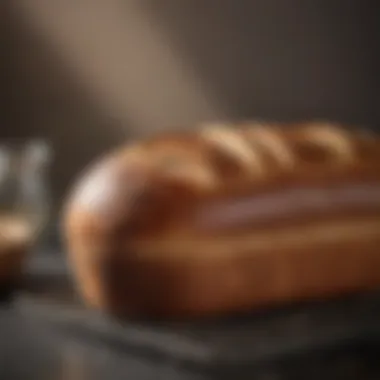
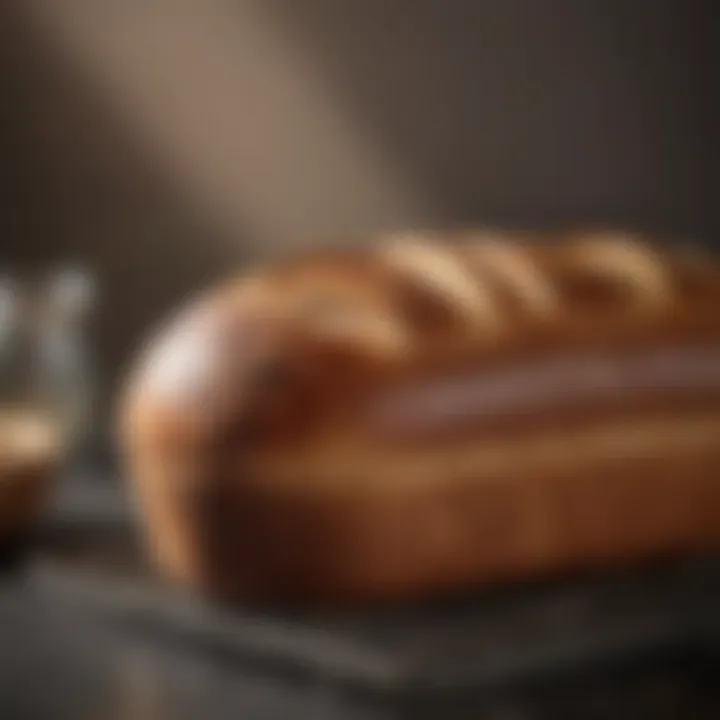
Bread often marks the highlight of many rituals and celebrations, transcending its role as food. Think about weddings, for instance—different cultures incorporate unique bread rituals that symbolize unity and prosperity. In many Mediterranean regions, cakes or bread are shared among guests to signify luck and fertility.
During major holidays like Thanksgiving in the United States, bread takes the form of stuffing, fusing flavor and tradition. It embodies the idea of gratitude—echoed with each slice served at the table, surrounded by family members. Likewise, in Jewish tradition, challah is a braided bread that is important during Shabbat and holidays. It not only plays a role in the ritual but also stands as a reminder of the divine and the eternal bonds within families.
The diverse array of bread across cultures serves as an indicator of communal ties. Each loaf, whether it's a simple flatbread or a rich brioche, carries with it customs and stories, knitting communities together through generations. By cherishing the significance of bread, we can appreciate the deeper connections it creates within our culinary experiences.
Innovative Bread Recipes
Bread is more than just a staple; it’s a canvas for creativity. This section dives into the realm of innovative bread recipes, which not only highlight culinary artistry but also serve practical benefits for those who bake. With the plethora of flavors and textures available today, innovative bread recipes allow bakers to experiment beyond traditional boundaries. They can cater to dietary restrictions, embrace local flavors, or even incorporate unexpected ingredients that provoke excitement at the dinner table. The beauty of these recipes lies in their adaptability—whether you’re a novice or seasoned baker, exploring them can transform your understanding and appreciation of bread-making.
"Bread is the touchstone of food creativity; it can become whatever you envision."
Breakfast Breads: Quick and Nutritious
When mornings are tight, breakfast breads come to the rescue. These recipes are designed to provide a nutritious start without consuming too much time. Consider banana bread, which combines fiber-rich bananas and wholesome oats, offering energy and sustenance. You can also try making zucchini bread, which sneaks in a portion of vegetables while keeping the taste sweet and fulfilling.
Don’t forget about savory options like cheese and chive muffins that can power you through the day. These are not just quick but also customizable—add nuts, seeds, or fruits based on your preferences.
- Benefits of Breakfast Breads:
- Time-efficient: Bake ahead and enjoy throughout the week.
- Health-focused: Incorporate fruits, veggies, or whole grains for better nutrition.
- Versatile: Modify recipes to fit personal taste.
Perfect Pairings for Family Dinners
Family dinners often revolve around shared experiences and memories, and bread can play a pivotal role in these gatherings. Innovative recipes can easily be paired with main dishes to enhance flavors and textures. For example, herb-infused focaccia can elevate a simple pasta dish, while garlic bread complements a rich lasagna beautifully.
Creating a selection of breads also brings a festive element to dinner. Consider a platter featuring different types such as warm cornbread, crusty baguettes, or rosemary olive bread. Each bread can carry its unique flavors, making every bite a delightful exploration.
- Thoughts on Perfect Pairings:
- Enhances Meal: Bread can balance and elevate the palate.
- Encourages Sharing: A loaf encourages family-style serving.
- Cultural Exploration: Different breads can introduce international flavors.
Creative Sandwiches and Fillings
Sandwiches are a blank slate for creativity, whether you're opting for traditional deli-type or tapping into gourmet territory. Start with a dense whole grain bread or go for a light ciabatta; the choice of bread itself sets the stage. For fillings, think beyond the typical cold cuts; consider roasted veggies, herbed cheese spreads, or even spiced hummus.
Putting together an innovative sandwich also allows for fun flavor combinations. How about a turkey sandwich with cranberry mayo or a vegan option featuring avocado and chickpea spread? The key is to mix textures and flavors in a way that excites the palate while providing sustenance.
- Key Elements of Creative Sandwiches:
- Bread Variety: Use different types for texture and flavor variations.
- Filling Diversity: Don’t be afraid to experiment with unique ingredients.
- Balancing Flavors: Sweet, savory, and umami elements can coexist beautifully.
Adapting to a Busy Lifestyle
In today’s fast-paced world, the art of bread-making may seem like a daunting task. However, adapting the process to fit bustling schedules is not only possible but also practical. Embracing bread-making in a busy lifestyle can offer both comfort and satisfaction. Homemade bread brings a sense of accomplishment and a chance to bond with family or friends, creating lasting memories over shared meals.
Moreover, the flexibility inherent in baking allows one to tailor the process to individual time restraints. Whether you’re rushing from work to home or managing a busy household, modifying your approach means still enjoying the fruits of your labor—freshly baked bread. Thus, understanding various time-saving techniques, batching recipes, and efficient use of kitchen equipment can transform bread-making from a leisurely activity into an easily integrated part of daily life.
Time-Saving Techniques in Bread-Making
When life feels like a whirlwind, implementing time-saving techniques can ease the burdens of bread-making without sacrificing quality. One effective method is the no-knead bread technique, which allows dough to develop flavor over time, minimizing active preparation.
- Mix and Stand: Combine ingredients and let the mixture rest for an extended period. Simple yet effective, this method uses time to work for you, enhancing the flavor and texture of the bread without the need for constant attendance.
- Cold Fermentation: Refrigerating your dough allows for more flexibility in your schedule. Simply shape your dough, place it in the fridge overnight or even up to a few days, and bake when you’re ready. This not only deepens flavor but also gives you the freedom to bake whenever it suits you.
With such techniques, the time invested in preparation yields delicious returns, ensuring that homemade bread doesn't become a burden, but rather a pleasure.
Batch Baking: Preparing Ahead
The wonders of batch baking cannot be overstated. If time is short during the week, why not dedicate a day to make multiple loaves? This practice not only saves time but ensures that you have fresh bread on hand whenever you need it.
- Pre-packaged Portions: When baking large batches, slice and freeze portions for later use. This allows you to defrost just what you need without worrying about bread going stale.
- Variations on a Theme: Consider baking different types at once. Mixing a classic white loaf with a whole grain option provides variety without much extra effort.
Moreover, engaging children or family members in the batch baking can turn it into a fun, shared experience. Involving loved ones can help instill a sense of teamwork while teaching valuable culinary skills.
Efficient Use of Kitchen Equipment
Maximizing kitchen tools can play a charity role in making bread-making more manageable. Not all of us have the luxury of time (or space); hence knowing how to utilize your belongings effectively is essential.
- Stand Mixer vs. Hand Kneading: A stand mixer can be a game-changer, especially when scaling up recipes. Instead of kneading dough by hand, let the machine do the heavy lifting, freeing your hands for other tasks.
- Bread Machine Wonders: For those particularly strapped for time, bread machines provide an easy solution. Toss in your ingredients and let the machine do the rest. You can wake up to or come home to the delightful aroma of fresh bread awaiting you.
Efficient use of equipment can tremendously increase the overall effectiveness of the process, especially for those opting to integrate bread-making into a busy lifestyle.
"[Bread-making is a blend of science and art. Balancing these aspects leads not only to exceptional bread but also to a fulfilling experience in the kitchen.]"
Embracing the art of bread-making amidst a busy routine is achievable with the right strategies, granting the pleasures of homemade delights without the overwhelming weight of time constraints.
The End
The conclusion of an extensive guide on bread-making serves a vital purpose: it wraps up the discourse while reaffirming key insights learned throughout the narrative. By reflecting on both the science and creativity behind bread, this section not only summarizes what’s been discussed but also emphasizes the significance of embracing bread-making as a fulfilling culinary journey.
Embracing the Art of Bread-Making
Engaging in bread-making is more than just following recipes; it’s about immersing oneself in a rich tapestry of textures and flavors. In the world where fast food has become the norm, kneading dough and watching it rise can be a grounding ritual. The process can often feel therapeutic, instilling patience as you interact with the living ingredients. It’s a craft that invites people of all ages to gather around the kitchen. Here, warm slices of freshly baked bread bring not only nourishment but also connection.
Consider the sensory experience: the smell of yeast working its magic, the sound of a crust crackling as it cools, and the taste of a warm loaf right out of the oven. All these aspects encapsulate what it means to truly embrace bread-making. It transcends mere sustenance, creating a deeper appreciation for the food we consume. Plus, understanding the techniques enhances one’s culinary repertoire, equipping home cooks with skills that go far beyond bread.
Encouraging Culinary Exploration
Bread-making is an open invitation to explore and experiment. It provides a rich canvas for creativity. With foundational techniques in place, individuals are encouraged to venture into unfamiliar territories. The beauty of the culinary arts lies in the ability to modify recipes and adapt them to personal tastes. For example, you might want to incorporate herbs into a basic sourdough or try an array of grains for added texture in artisan breads.
Moreover, sharing baked goods fosters camaraderie and fuels inspiration. Each loaf tells a story, whether it’s a focus on local grains, or a twist borrowed from global traditions. People can engage in passionate discussions on sourdough starters, types of flour, or the importance of fermentation, which can spark fiery debates among enthusiasts.







